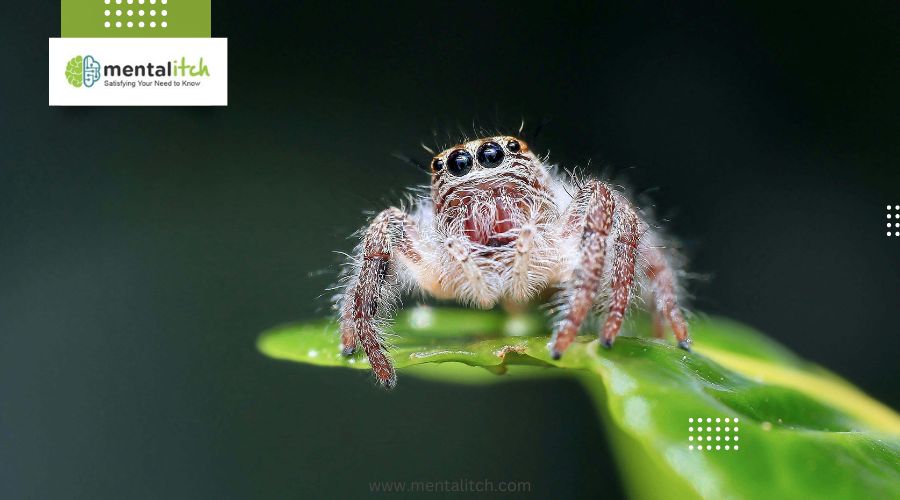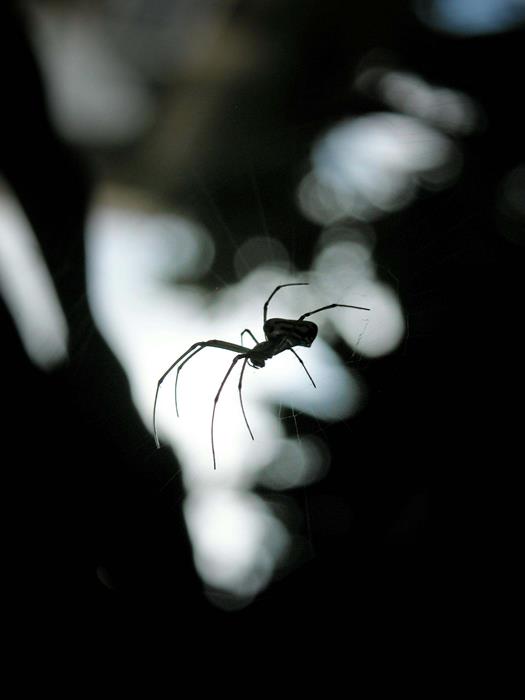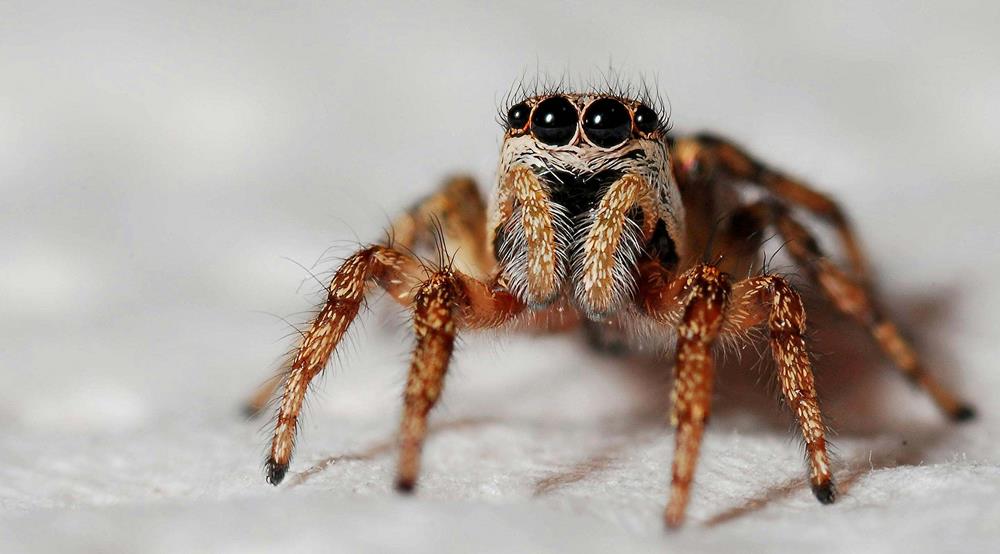Meet the Ogre-Faced Spider, an extraordinary arachnid that calls diverse habitats home. This spider, known for its unique features and behaviors, is found in various countries, showcasing its adaptability to different environments. While its presence is notable in several countries, the Ogre-Faced Spider’s key aspect lies in its hunting techniques. Its ability to patiently and strategically capture prey sets it apart, making it a master of ambush tactics. But thats not just it! Theres so much more which differentiates the ogre-faced spider from regular spiders.
What Makes the Ogre-Faced Spider Different?
The Ogre-faced spider is different from a regular spider due to its physical appearance, hunting tactics, vision, adaptation, entomology, and several other aspects. Lets begin with the physical appearance.
Physical Characteristics
The Ogre-Faced Spider, scientifically known as Deinopis, features a distinctive and intriguing appearance that sets it apart in the spider kingdom. Typically, it has a body length ranging from 1 to 2 centimeters, with long, slender legs that can span up to 8 centimeters. Its coloration varies, often blending with the natural surroundings, allowing for effective camouflage during its hunting activities.
The body of the Ogre-Faced Spider is streamlined and elongated, featuring a cylindrical abdomen and a cephalothorax, which is the fused head and thorax. Unlike many spiders, its most striking feature is its enormous, forward-facing eyes. The spider possesses two large, primary eyes that are significantly larger than the remaining six, creating a unique arrangement. These eyes, resembling precious gems, contribute to its exceptional visual capabilities.
The Ogre-Faced Spider’s most noteworthy feature is its two enormous, front-facing eyes. These eyes, which can be up to 2.5 millimeters in diameter, provide exceptional binocular vision. This adaptation allows the spider to accurately judge distances and accurately target prey during its nocturnal hunts.
The spider’s coloration and texture play a crucial role in its ability to blend seamlessly with its surroundings. Relying on a palette of browns, grays, and greens, the Ogre-Faced Spider becomes virtually invisible on tree bark or foliage. This camouflage is essential for its ambush hunting strategy, as it remains concealed while awaiting unsuspecting prey.
While the Ogre-Faced Spider doesn’t construct elaborate webs like some of its relatives, it still produces silk. The silk is used to create a unique web structure known as a ‘net.’ This triangular net is held between the spider’s front legs and is rapidly deployed to ensnare prey when the spider senses vibrations.
The spider’s long, slender legs are equipped with flexible joints, enabling precise movement and allowing it to navigate various terrains. This flexibility is crucial for ambushing prey effectively and swiftly striking when the opportune moment arises.
Hunting Techniques
The Ogre-Faced Spider, scientifically known as Deinopis, showcases some remarkable hunting techniques that set it apart from other spiders.
The Ogre-Faced Spider is a master of stealth and patience when it comes to capturing its prey. Unlike many spiders that passively wait for prey to stumble into their webs, the Ogre-Faced Spider takes a more active approach. Instead of building a traditional web, it constructs a small, delicate silk structure between its front legs, resembling a net.
This spider is a nocturnal hunter, preferring to hunt during the darkness of the night. It hangs upside down from a silk line it creates and holds its small net-like web with its front legs. The spider then relies on its keen sense of touch to detect vibrations from nearby insects. Once a potential prey item is sensed, the Ogre-Faced Spider makes its move, lunging downward with lightning speed to ensnare its victim in the silk net.
One of the Ogre-Faced Spider’s most distinctive features is its large, forward-facing eyes. This arachnid has two enormous eyes, each several times larger than the others. These massive eyes contribute significantly to its hunting success.
The large eyes provide the Ogre-Faced Spider with exceptional night vision, allowing it to navigate and hunt effectively in low-light conditions. Research indicates that the Ogre-Faced Spider can see prey items from a distance of up to two feet in complete darkness. This extraordinary visual capability gives it a significant advantage over other spiders, making it a formidable nocturnal predator.
Furthermore, the arrangement of the eyes provides the spider with a unique binocular field of vision. This means that it can accurately judge the distance to its prey, enabling precise and targeted strikes. The combination of the specialized net-building technique and the exceptional vision conferred by its large eyes makes the Ogre-Faced Spider a highly efficient and successful hunter in the nighttime landscapes it inhabits.
Net Casting
The Ogre-Faced Spider, known for its cunning hunting techniques, possesses a web that stands out in the spider kingdom. Unlike the classic orb-shaped webs that many spiders create, the Ogre-Faced Spider employs a unique strategy in web construction that reflects its specialized hunting behavior.
This spider does not rely on a permanent, large web but instead crafts a small, delicate silk structure between its front legs. This structure resembles a net, and it serves as a crucial tool in the spider’s hunting arsenal. The construction process begins with the spider producing silk from its silk glands. Using its front legs, it carefully weaves and shapes the silk into a net-like structure.
The design of the net allows the Ogre-Faced Spider to hold it with precision and readiness. Positioned between its front legs, the spider patiently waits for potential prey to approach, sensing vibrations through the silk. This unique net serves as both a trap and a tool for the spider’s strategic hunting approach.
The net-like structure, when held between the spider’s front legs, allows for quick deployment. When the spider senses vibrations indicative of potential prey, it swiftly lowers the web, ensnaring the unsuspecting victim. This rapid and precise action is crucial for the spider’s success in capturing prey.
Additionally, the construction of a small, portable web reduces the chances of it getting damaged or attracting unwanted attention from predators. The Ogre-Faced Spider’s web, tailored to its unique hunting strategy, exemplifies the adaptability of this arachnid in optimizing its environment for effective predation.
Sensory Adaptations
The Ogre-Faced Spider’s power in hunting is intricately linked to its remarkable sensory adaptations. Unlike many spiders, this arachnid has evolved specialized senses that contribute significantly to its survival and success in capturing prey.
One of the key sensory adaptations of the Ogre-Faced Spider is its heightened touch sensitivity. This spider possesses fine sensory hairs on its body, especially on its legs. These hairs are incredibly sensitive to vibrations, allowing the spider to detect even the faintest movements in its surroundings. This heightened touch sensitivity is particularly crucial for its nocturnal hunting strategy, where the spider relies on vibrations to locate potential prey.
The Ogre-Faced Spider boasts an extraordinary visual system that plays a pivotal role in its hunting prowess. With two enormous, forward-facing eyes, this arachnid has exceptional night vision. These eyes are adapted to low-light conditions, enabling the spider to navigate and hunt effectively during the darkness of the night. The large size of its eyes provides a wide field of vision, contributing to its ability to detect prey from a distance.
The acute touch sensitivity enables the Ogre-Faced Spider to sense vibrations from potential prey from a considerable distance. This adaptation is particularly beneficial for its ambush strategy, allowing the spider to remain patient while waiting for the opportune moment to strike. By strategically positioning itself in an elevated location and relying on touch-sensitive hairs, the spider maximizes its chances of a successful ambush.
The exceptional night vision conferred by the large, forward-facing eyes gives the Ogre-Faced Spider a distinct advantage during nocturnal hunting. While many spiders are less active or rely on fixed webs during the night, the Ogre-Faced Spider can actively pursue prey with its unique vision. This adaptation allows it to exploit the darkness, outperforming other spiders that may struggle in low-light conditions.
Final Words
The Ogre-Faced Spider emerges as a nocturnal marvel, weaving its success through patient ambushing and sensory finesse. You can find it in some of the oldest trees in the world too! Its unique blend of touch sensitivity and exceptional night vision showcases nature’s artistry in adaptation. This arachnid’s ingenious hunting strategies, from constructing delicate nets to executing lightning-fast strikes, underscore its mastery in survival. The Ogre-Faced Spider beckons us to appreciate the intricacies of its world, where patience, strategy, and heightened senses converge, making it a captivating protagonist in the drama of the natural kingdom.


